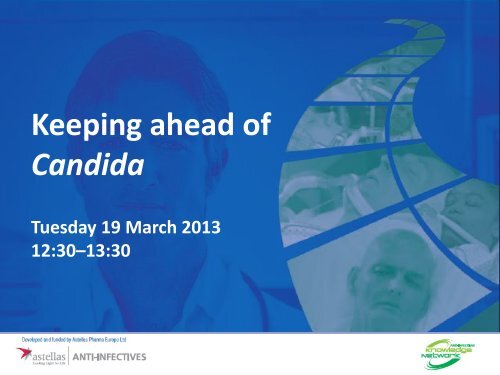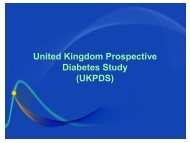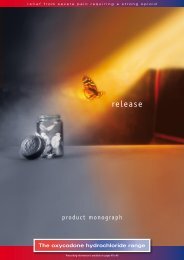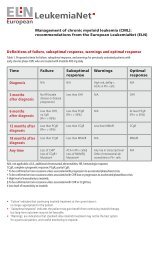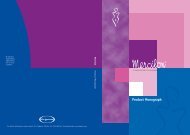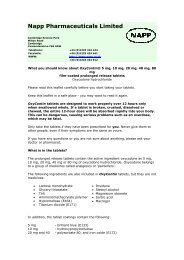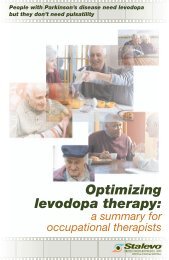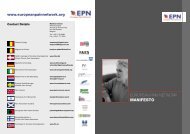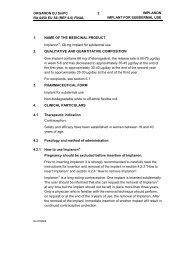Immunité antifongique - epgonline.org
Immunité antifongique - epgonline.org
Immunité antifongique - epgonline.org
Create successful ePaper yourself
Turn your PDF publications into a flip-book with our unique Google optimized e-Paper software.
Keeping ahead of<br />
Candida<br />
Tuesday 19 March 2013<br />
12:30–13:30
Disclaimer information<br />
Please note: This meeting may include reference<br />
to use of some products in unlicensed indications<br />
Please refer to the manufacturer’s prescribing information
Chair’s welcome<br />
Ge<strong>org</strong>e Dimopoulos<br />
(Greece)<br />
AI/12/0053/EUf Date of preparation March 2013
Faculty<br />
• Chair:<br />
Ge<strong>org</strong>e Dimopoulos<br />
(Greece)<br />
• Philippe Montravers<br />
(France)<br />
• Robert Masterton<br />
(UK)
Agenda<br />
Welcome<br />
Getting treatment right from the start<br />
Maintaining effective treatment<br />
Q&A followed by closing summary<br />
Ge<strong>org</strong>e Dimopoulos<br />
(Greece)<br />
Philippe Montravers<br />
(France)<br />
Robert Masterton<br />
(UK)<br />
Ge<strong>org</strong>e Dimopoulos<br />
(Greece)
Meeting materials<br />
• Meeting summary book<br />
• Question cards<br />
• Evaluation form
Discussion sessions<br />
• This is an interactive meeting – questions are encouraged…<br />
• Please use the question cards in the meeting books<br />
• Please state clearly who your question is for<br />
• Question cards will be collected by meeting staff
Anti-Infectives Knowledge Network<br />
• More information on the topics covered in this symposium<br />
can be found at www.aiknowledgenetwork.eu,<br />
the Anti-Infectives Knowledge Network part of EPG Online<br />
• Carrying news, downloadable resources, videos and expert<br />
interviews, the site is of interest to all involved in the ID field
Mobile telephones and devices<br />
• Please ensure that all mobile devices are turned to<br />
silent in the auditorium
Introduction
Critically ill patient<br />
Dimopoulos G et al J Crit Care 2013 (in press)<br />
Suspected<br />
Fungal infection<br />
Proven Blood cultures (+)<br />
Biopsy (+)<br />
Targeted treatment according to<br />
- Guidelines<br />
- Local Epidemiology<br />
Risk factors (+)<br />
Clinical signs (-)<br />
Biomarkers (-)<br />
Mycology (-)<br />
Risk factors (+)<br />
Biomarkers (+)<br />
Clinical signs (-)<br />
Mycology (-)<br />
Risk factors (+)<br />
Clinical signs (+)<br />
Biomarkers (-)<br />
Mycology (-)<br />
How to select the antifungal agent <br />
Hemodynamically unstable patient<br />
Prophylaxis<br />
Fluconazole<br />
Pre-emptive<br />
Treatment<br />
Empirical<br />
treatment<br />
NO<br />
YES<br />
Echinocandins<br />
YES<br />
Azole resistance<br />
Recent exposure<br />
Local epidemiology<br />
Colonization<br />
Echinocandins<br />
Patient is stabilized <br />
Consider step-down to<br />
Voriconazole or Fluconazole<br />
Alternative<br />
L-AmphoB<br />
Alternatives<br />
-Echinocandins<br />
-Voriconazole<br />
-L-AmphoB<br />
NO<br />
FLUCONAZOLE
Discussion<br />
Please hand completed<br />
question cards to meeting staff
Chair’s summary<br />
Ge<strong>org</strong>e Dimopoulos<br />
(Greece)
Keeping ahead of Candida<br />
• Candidaemia continues to be associated with high mortality<br />
rates 1–3<br />
• Delaying treatment increases mortality 4,5<br />
– However, starting treatment based solely on risk factors is difficult, as<br />
many are common to ICU patients 6<br />
• Treatment optimisation can improve outcomes and resource<br />
utilisation 7<br />
– De-escalation appears to be a clinically and cost-effective approach to<br />
improving outcomes in patients with candidaemia 8<br />
1. Calandra T, Marchetti O. Clin Infect Dis 2004;39:S185–92; Andes DR, et al. Clin Infect Dis 2012;54:1110–22<br />
3. Cornely OA, et al. Clin Microbiol Infect 2012;18(Suppl. 7):19–37; 4. Garey KW, et al. Clin Infect Dis 2006;43:25–31<br />
5. Morrell M, et al. Antimicrob Agents Chemother 2005;49:3640–5; 6. Guery BP, et al. Intensive Care Med 2009;35:55–62<br />
7. Masterton RG. Crit Care Clin 2011;27:149–62; 8. Masterton RG, et al. In press
Your feedback is important…<br />
• Please complete the<br />
evaluation form<br />
• Hand forms to meeting<br />
staff at the exit
MYCAMINE (micafungin)<br />
ABBREVIATED PRESCRIBING INFORMATION<br />
(Consult the summary of product characteristics for full prescribing and adverse event information)<br />
Presentation: Powder for solution for infusion. Each vial contains 50mg or 100mg micafungin sodium. Reconstituted 50mg vial contains 10mg/ml; 100mg vial contains 20mg/ml<br />
of micafungin sodium. Indications: In adults, adolescents and children including neonates: treatment of invasive candidiasis; prophylaxis of Candida infection in allogeneic<br />
haematopoietic stem cell transplantation patients or those expected to have neutropenia (ANC
Keeping ahead of<br />
Candida<br />
Tuesday 19 March 2013<br />
12:30–13:30


